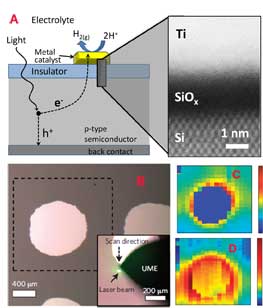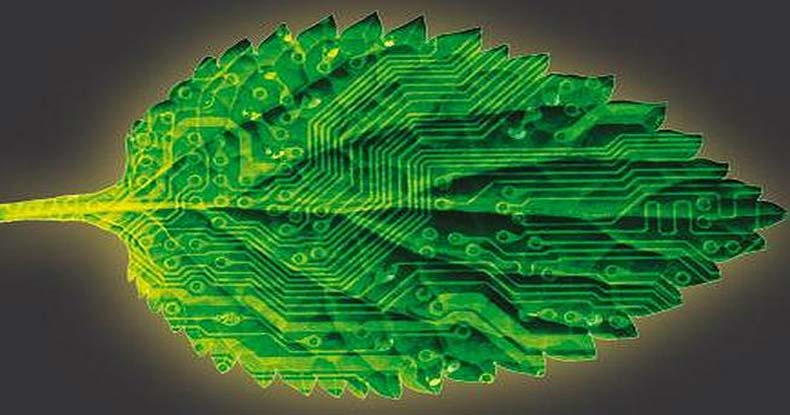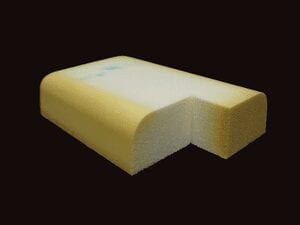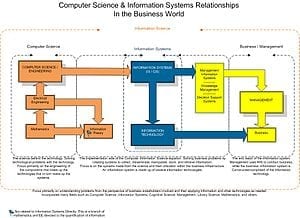
It is 15 times better than previously reported results for similar silicon-based MIS devices
Using a powerful combination of microanalytic techniques that simultaneously image photoelectric current and chemical reaction rates across a surface on a micrometer scale, researchers at the National Institute of Standards and Technology (NIST) have shed new light on what may become a cost-effective way to generate hydrogen gas directly from water and sunlight.*
Their quarry is a potentially efficient, cost-effective, photoelectrochemical (PEC) cell—essentially a solar cell that produces hydrogen gas instead of electric current. “A major challenge with solar energy is dealing with solar intermittency,” says NIST chemical engineer Daniel Esposito. “We demand energy constantly, but the sun’s not always going to be shining, so there’s an important need to convert solar energy into a form we can use when the sun’s not out. For large-scale energy storage or transportation, hydrogen has a lot of benefits.”
At its simplest, a PEC cell contains a semiconducting photoelectrode that absorbs photons and converts them into energetic electrons, which are used to facilitate chemical reactions that split water molecules into hydrogen and oxygen gases. It’s not that easy. The best PEC cell has been demonstrated with an efficiency around 12.5 percent,** says Esposito. But, “it’s been estimated that such a cell would be extremely expensive—thousands of dollars per square meter—and they also had issues with stability,” he says. One big problem is that the semiconductors used to achieve the best conversion efficiency also tend to be highly susceptible to corrosion by the cell’s water-based electrolyte. A PEC electrode that is efficient, stable and economical to produce has been elusive.
The NIST team’s proposed solution is a silicon-based device using a metal-insulator-semiconductor (MIS) design that can overcome the efficiency/stability trade-off. The key is to deposit a very thin, but very uniform, layer of silicon dioxide—an insulator—on top of the semiconductor—silicon—that is well-suited for doing the photon-gathering work. On top of that is a polka-dot array of tiny electrodes consisting of platinum-covered titanium. The stable oxide layer protects the semiconductor from the electrolyte, but it’s thin enough and transparent enough that the photons will travel through it to the semiconductor, and the photo-generated electrons will “tunnel” in the opposite direction to reach the electrodes, where the platinum catalyzes the reaction that produces hydrogen.
The MIS device requires good production controls—the oxide layer in particular has to be deposited precisely—but Esposito notes that they used fabrication techniques that are standard in the electronics industry, which has decades of experience in building low-cost, silicon-based devices.
To study the system in detail, the NIST team scanned the surface of the device with a laser beam, illuminating only a small portion at a time to record photocurrent with micrometer resolution. In tandem with the beam, they also tracked an “ultramicroelectrode” across the surface to measure the rate of molecular hydrogen generation, the chemical half of the reaction.*** The combination allowed them to observe two bonus effects of the MIS photoelectrode design: a secondary mechanism for hydrogen generation caused by the channeling of electrons through the oxide layer, and a more efficient transport of electrons to the reaction site than predicted.
The NIST team calculates an efficiency of 2.9 percent for their device, which also exhibits excellent stability during operation. While this efficiency is far lower than more costly designs, they note that it is 15 times better than previously reported results for similar silicon-based MIS devices, and the new data from their microanalysis of the system points towards several potential routes to improving performance.
The Latest Bing News on:
Solar-Powered Hydrogen Generation
- Toyota goes large on hydrogen with new US headquarterson May 1, 2024 at 10:34 am
Toyota today announced that it's turning its R&D office in Los Angeles into its new North American hydrogen headquarters.
- Toyota Establishes North American Hydrogen HQon May 1, 2024 at 7:24 am
Reaffirming its commitment to support fuel cell and additional hydrogen-related products and technology toward a hydrogen economy, Toyota Motor North ...
- The looming electrical power shortageon May 1, 2024 at 7:00 am
Many states in the U.S. are headed for a serious and prolonged shortage of electrical power not seen in decades.
- This New Development Shows Toyotas Unwavering Commitment Towards Hydrogen Fuel Cell Technologyon May 1, 2024 at 6:45 am
Despite lots of promises, the future of hydrogen tech in the U.S ... This flexible microgrid includes a 230-kW solar photovoltaic system, a 1-MW stationary proton exchange membrane (PEM) fuel cell ...
- New model shows how to power homes exclusively with hydrogen, solar, batterieson May 1, 2024 at 6:01 am
Researchers in Spain has found that combining PV power generation with fuel cells and battery storage may help homes considerably reduce their levelized cost of energy. Their simulation reportedly ...
- Decarbonizing the Power Industry with Low-Carbon-Intensity Hydrogenon April 30, 2024 at 5:00 pm
Often, when people envision renewable energy, they think of energy sources like solar and wind ... ideal for early endeavors into decarbonizing power generation. The industrial gas industry has ...
- Scientist hails commercial feasibility of Saudi Arabian hydrogen city planon April 30, 2024 at 7:35 am
Alberto Boretti was a senior research professor at Prince Mohammad Bin Fahd University in 2021 when he first started discussing the idea of a hydrogen city in Al Khobar, Saudi Arabia. The New ...
- Stock Market Crash Warning: Don’t Get Caught Holding These 3 Hydrogen Stockson April 30, 2024 at 7:00 am
Equities related to the once-burgeoning hydrogen market are largely worth avoiding in 2024. The demand for renewable energy, especially one as expensive to produce and transport as hydrogen, has been ...
- Hydrogen Offers Germany a Chance to Take a Lead in Green Energyon April 29, 2024 at 9:01 pm
A subsidiary of ThyssenKrupp, Germany’s venerable steel producer, is landing major deals for a device that makes the clean-burning gas from water.
- SJVN begins Centralized Operations of Nathpa Jhakri and Rampur Hydro Power Stationson April 25, 2024 at 4:39 am
Green Hydrogen Generation Plant of the nation has been inaugurated by Chairperson and Managing Director, Smt. Geeta Kapur on April 24, 2024.
The Latest Google Headlines on:
Solar-Powered Hydrogen Generation
[google_news title=”” keyword=”Solar-Powered Hydrogen Generation” num_posts=”10″ blurb_length=”0″ show_thumb=”left”]
The Latest Bing News on:
Photoelectrochemical cell
- Here are the best credit cards for cell phone protection of May 2024on May 1, 2024 at 12:00 am
But there's a way you can avoid paying steep costs for damage to or theft of your phone — simply pay for your monthly cell phone bill with an eligible credit card that offers a complimentary ...
- Best cell phone deals in May 2024on April 29, 2024 at 12:57 pm
Cell phone deals are easy to find these days. Whether you're looking for unlocked phones, prepaid phones, or the best cheap phones worth buying, retailers have made it easier than ever to score ...
- The best cheap cell phone plans for May 2024on April 29, 2024 at 10:07 am
We've rounded up all the best cheap cell phone plans into one handy, easy-to-navigate list right here on this page. If you're looking to cut those hefty bills down to size, let us help you out ...
- Best cell phone plans for seniors in 2024on April 24, 2024 at 4:52 pm
The best cheap cell phone plans — whether it's for seniors or for anyone at any age — deliver great value by including strong service and perks with affordable prices. In our search for the ...
- Cells may possess hidden communication systemon April 23, 2024 at 5:00 pm
Cells constantly navigate a dynamic environment, facing ever-changing conditions and challenges. But how do cells swiftly adapt to these environmental fluctuations? A new Moffitt Cancer Center ...
- Cancer Cells Give Orderson April 22, 2024 at 4:59 pm
View full profile. Learn about our editorial policies. “[It is] interesting work that further highlights the complex intercellular crosstalk between stromal cells in cancer,” said Giulia Biffi, a ...
- Golden line: See what cell providers offer senior discountson April 21, 2024 at 3:30 am
As cell phones become increasingly integral for communication, the more experienced at life can take advantage of plans marketed towards those over 55. Here are the senior discounts and plans ...
- The 7 best cell phones of 2024 go way, way beyond talking and textingon April 18, 2024 at 11:01 am
The latest smartphone can handle so much more than just calls or texts. They're powerful communications, productivity, fitness and entertainment devices -- plus so much more. But that also means ...
- Four-terminal tandem organic solar cell achieves 16.94% efficiencyon April 16, 2024 at 5:01 pm
“Our research holds potential applications in photoelectrochemical cells, addressing crucial electrical requirements such as providing the necessary voltage to surpass established for driving ...
- Bias distribution and regulation in photoelectrochemical overall water-splitting cellson April 8, 2024 at 12:55 pm
More information: Kun Dang et al, Bias distribution and regulation in photoelectrochemical overall water-splitting cells, National Science Review (2024). DOI: 10.1093/nsr/nwae053 Provided by ...
The Latest Google Headlines on:
Photoelectrochemical cell
[google_news title=”” keyword=”Photoelectrochemical cell” num_posts=”10″ blurb_length=”0″ show_thumb=”left”]










